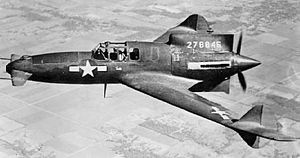Curtiss-Wright XP-55 Ascender
| XP-55 Ascender | |
|---|---|
 |
|
| Curtiss XP-55 Ascender in flight. | |
| Role | Fighter |
| Manufacturer | Curtiss-Wright Corporation |
| First flight | 19 July 1943 |
| Status | Cancelled at flight-test stage. |
| Number built | 3 |
The Curtiss-Wright XP-55 Ascender (company designation CW-24) was a 1940s United States prototype fighter aircraft built by Curtiss-Wright. Along with the Vultee XP-54 and Northrop XP-56, it resulted from United States Army Air Corps proposal R-40C issued on 27 November 1939 for aircraft with improved performance, armament and pilot visibility over existing fighters; it specifically allowed for unconventional aircraft designs. A highly unusual design for its time, it had a canard configuration, a rear-mounted engine, swept wings and two vertical tails. Because of its pusher design, it was sarcastically referred to as the "Ass-ender". Like the XP-54, the Ascender was initially designed for the Pratt & Whitney X-1800 engine and had to be redesigned when that engine project was cancelled. It was also the first Curtiss fighter aircraft to use tricycle landing gear.
On 22 June 1940, the Curtiss-Wright company received an Army contract for preliminary engineering data and a powered wind tunnel model. The designation P-55 was reserved for the project. The USAAC was not completely satisfied with the results of these tests, and Curtiss-Wright took it upon itself to build a flying full-scale model which it designated CW-24B. The flying testbed was powered by a 275 hp (205 kW) Menasco C68-5 inline engine. It had a fabric-covered, welded steel tube fuselage with a wooden wing. The undercarriage was non-retractable.
...
Wikipedia
